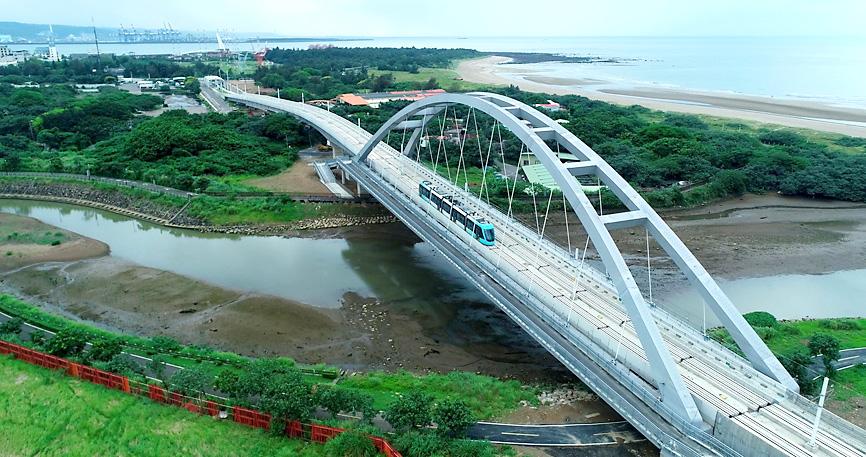A new section of the Danhai Light Rail Transit system in New Taipei City is to begin operating today, extending the service to Tamsui Fisherman’s Wharf (淡水漁人碼頭), a popular scenic spot.
Following an opening ceremony at 10am, service on the Blue Seaside Line near the Tamsui River (淡水河) would start at 2pm, New Taipei Metro Corp said.
The new 2km section of the light rail network connects at Binhai Shalun Station with the existing Green Mountain Line, which has 11 stations and runs from Hongshulin MRT Station to Kanding Station, the company said.

Photo provided by New Taipei Metro Corp
It means that people would be able to travel directly from Hongshulin (紅樹林) to Fishermen’s Wharf, it said.
The service from Hongshulin is to alternate between Kanding (崁頂) and Fishermen’s Wharf every seven to eight minutes, from 6am to midnight.
The new line is the first metro route in the nation that offers passengers a clear view of the Taiwan Strait, and also includes a section called the Blue Seaside Bridge that runs 120.7m across a stream between the Taipei University of Marine Technology and Shalun stations, New Taipei Metro said.
On Wednesdays and Fridays, there would be light shows on the bridge from 6pm to 10pm, the city’s Department of Rapid Transit Systems said.
With the expansion of the light rail system, ridership is expected to increase from 9,000 to 44,000 per day, department deputy head Lin Yao-chang (林耀長) said.
Until Dec. 14, people with electronic metro passes would be able to travel free of charge between the Taipei University of Marine Technology, Shalun and Tamsui Fishermen’s Wharf stations, New Taipei Metro said.
The seaside line is scheduled to be completed in 2024, after an additional 5.71km section between Fisherman’s Wharf and Tamsui MRT Station is constructed.
The full plan for the Danhai light rail system is to build four lines — Blue, Green, Bali and Sanzhi — at a total cost of NT$15.3 billion (US$530.38 million).
The network is part of New Taipei City’s plan to develop its 1,748.7-hectare Danhai New Town (淡海新市鎮) area, which was launched in 1992 with a goal of attracting a population of 300,000 by 2036.

Taiwan is stepping up plans to create self-sufficient supply chains for combat drones and increase foreign orders from the US to counter China’s numerical superiority, a defense official said on Saturday. Commenting on condition of anonymity, the official said the nation’s armed forces are in agreement with US Admiral Samuel Paparo’s assessment that Taiwan’s military must be prepared to turn the nation’s waters into a “hellscape” for the Chinese People’s Liberation Army (PLA). Paparo, the commander of the US Indo-Pacific Command, reiterated the concept during a Congressional hearing in Washington on Wednesday. He first coined the term in a security conference last

Prosecutors today declined to say who was questioned regarding alleged forgery on petitions to recall Democratic Progressive Party (DPP) legislators, after Chinese-language media earlier reported that members of the Chinese Nationalist Party (KMT) Youth League were brought in for questioning. The Ministry of Justice Investigation Bureau confirmed that two people had been questioned, but did not disclose any further information about the ongoing investigation. KMT Youth League members Lee Hsiao-liang (李孝亮) and Liu Szu-yin (劉思吟) — who are leading the effort to recall DPP caucus chief executive Rosalia Wu (吳思瑤) and Legislator Wu Pei-yi (吳沛憶) — both posted on Facebook saying: “I

Sung Chien-liang (宋建樑), who led efforts to recall Democratic Progressive Party (DPP) Legislator Lee Kun-cheng (李坤城), was released on bail of NT$80,000 today amid outcry over his decision to wear a Nazi armband to questioning the night before. Sung arrived at the New Taipei District Prosecutors’ Office for questioning in a recall petition forgery case last night wearing a red armband bearing a swastika, carrying a copy of Adolf Hitler’s Mein Kampf and giving a Nazi salute. Sung left the building at 1:15am without the armband and covering the book with his coat. Lee said today that this is a serious

The Ministry of Economic Affairs has fined Taobao NT$1.2 million (US$36,912) for advertisements that exceed its approved business scope, requiring the Chinese e-commerce platform to make corrections in the first half of this year or its license may be revoked. Lawmakers have called for stricter enforcement of Chinese e-commerce platforms and measures to prevent China from laundering its goods through Taiwan in response to US President Donald Trump’s heavy tariffs on China. The Legislative Yuan’s Finance Committee met today to discuss policies to prevent China from dumping goods in Taiwan, inviting government agencies to report. Democratic Progressive Party Legislator Kuo Kuo-wen (郭國文) said